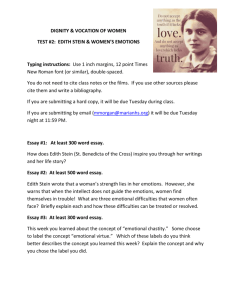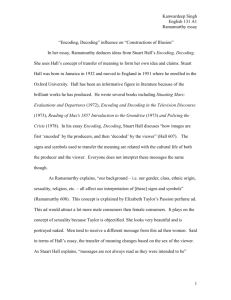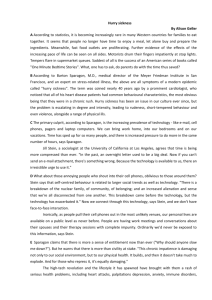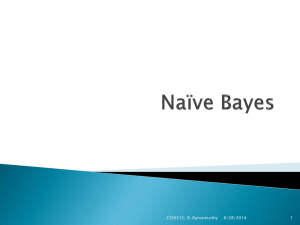MMontgomery12comments
advertisement
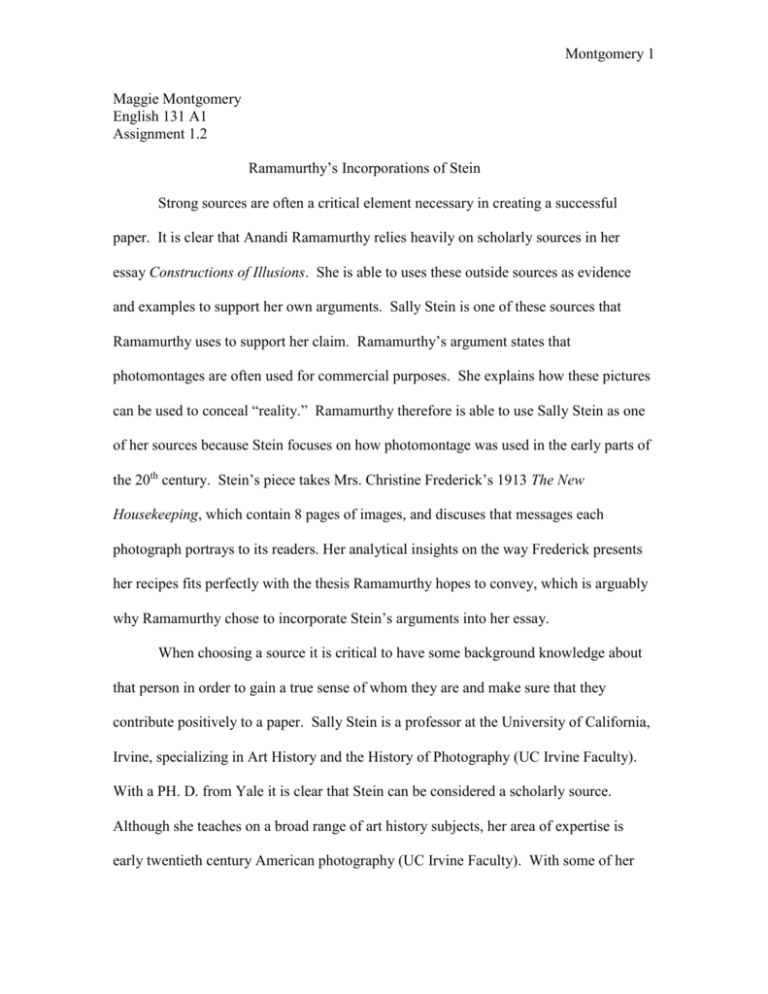
Montgomery 1 Maggie Montgomery English 131 A1 Assignment 1.2 Ramamurthy’s Incorporations of Stein Strong sources are often a critical element necessary in creating a successful paper. It is clear that Anandi Ramamurthy relies heavily on scholarly sources in her essay Constructions of Illusions. She is able to uses these outside sources as evidence and examples to support her own arguments. Sally Stein is one of these sources that Ramamurthy uses to support her claim. Ramamurthy’s argument states that photomontages are often used for commercial purposes. She explains how these pictures can be used to conceal “reality.” Ramamurthy therefore is able to use Sally Stein as one of her sources because Stein focuses on how photomontage was used in the early parts of the 20th century. Stein’s piece takes Mrs. Christine Frederick’s 1913 The New Housekeeping, which contain 8 pages of images, and discuses that messages each photograph portrays to its readers. Her analytical insights on the way Frederick presents her recipes fits perfectly with the thesis Ramamurthy hopes to convey, which is arguably why Ramamurthy chose to incorporate Stein’s arguments into her essay. When choosing a source it is critical to have some background knowledge about that person in order to gain a true sense of whom they are and make sure that they contribute positively to a paper. Sally Stein is a professor at the University of California, Irvine, specializing in Art History and the History of Photography (UC Irvine Faculty). With a PH. D. from Yale it is clear that Stein can be considered a scholarly source. Although she teaches on a broad range of art history subjects, her area of expertise is early twentieth century American photography (UC Irvine Faculty). With some of her Montgomery 2 works titled Montage and Modern Life and The Constant Meaning of Photography it is clear to see why Ramamurthy was drawn to Steins work. Because one of the main arguments Ramamurthy is trying to make is how advertisements often use photomontages to capture a viewers attention, Stein can be used a source because she too is making this argument. Ramamurthy’s is stating that photographers use photomontage to “conceal reality,” or expose “invisible social relations” (Ramamurthy, 610). She takes Steins analysis on Christine Frederick’s recipe card highlighting the fact that the viewers can over look the poor organization of the card because they are drawn the picture. Ramamurthy is pointing out that it is interesting that a recipe card can leave out important information such as number of servings or the cost of making that meal, which one can assume the reader of a recipe card would like to be aware of, and the viewers still find the card attractive (Ramamurthy, 611). Stein explains that these particle questions of time and cost can be overlooked because that is not the message Frederick’s hope to convey to her readers. Instead she wants to draw the reader in by showing the “family feast at its pinnacle” which makes the reader forego any possible questions of concern (Stein, 43). Stein’s focus as mentioned early, is early twentieth century American photography. During that time photography was a relatively new phenomenon and therefore an “ordinary image of a cake may have impressed an early twentieth-century audience” (Ramamurthy, 612). However both Stein and Ramamurthy express that in today’s world of new technology digital imagery more effectively captures the viewer’s attention (Ramamurthy, 612). Because both writers wish to express the important roll that technology plays on how the audience receives a photograph Ramamurthy is able to Montgomery 3 effectively use Stein’s writing to back up her claim. Ramamurthy further expand on the role of technology by capitalizing on its presents in TV commercials, print advertisements and even film. Technology often “makes us forget the context of production” which causes the viewers to simply see what is presented to them (Ramamurthy, 612). Because Ramamurthy’s essay Constructions of Illusion hopes to share the importance of photomontage in context with commercial uses, Sally Stein proves to be a good source to help support her reasoning. Steins vast knowledge on early twentieth century American photography along with her PH. D. from Yale University allow Ramamurthy to confidently quote and collaborate with Stein. Stein’s book The Constant Meaning of Photography create arguments similar to those made by Ramamurthy, making it simple for Ramamurthy to include them in her text. Montgomery 4 Work Cited Stein, Sally. “UC Irvine Faculty Profile System.” 3/29/02 <http://www.faculty.uci.edu/profile.cfm?faculty_id=3000>. 4/10/07. Ramamurthy, Anandi. “Constructions of Illusion.” Reading Context. New York: Thomson Wadsworth, 2005. 601-634. Montgomery 5 Maggie, The strongest points of this essay include the pointed observations made in the first part of the essay. They are notable not only for their insight but for also the choices made in deciding how much detail should be used in the explanations. The essay is smart to latch onto both authors’ ideas on photomontage as one relatively prominent node of exchange that emerges between the two essays. The point about Stein’s utility for Ramamurthy through the former’s work on photomontage is well taken – this aspect of the paper is also strong for the care taken to backing the reading with textual analysis. Still, the essay ends in a way that is not quite as strong as its initial exposition on the imbrications of the authors’ ideas. Perhaps it’s the turn to their common interest in technology that may throw off the analysis from the tight track it follows – the essay seems to take a turn at this point but the reader isn’t sure to what and how it’s related to what the essay is saying about photomontage. In addition to working on more effectively incorporating that paragraph, the essay could also follow through on the photomontage line of argument by considering how the authors differ in their interests in the subject. For instance, does Ramamurthy take photomontage in a different direction than Stein? The essay astutely points out that Stein is a foundation for Ramamurthy, but a foundation for what? Finally, there are some issues with spelling and other typos here and there. They can add up, so be sure to have a friend whose writing you trust proofread your essays, especially for the portfolio. Overall, this essay has some excellent ideas, with an especially strong start. I look forward to seeing how it evolves.

